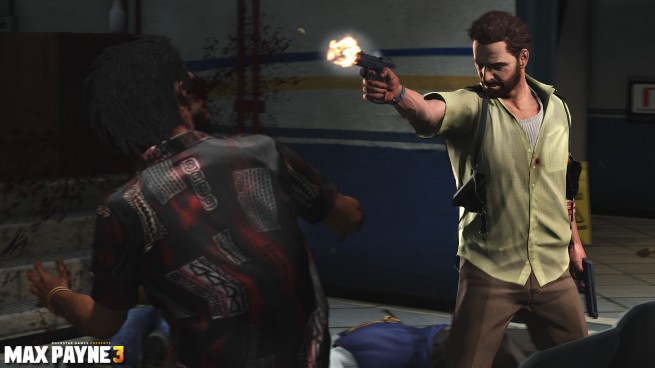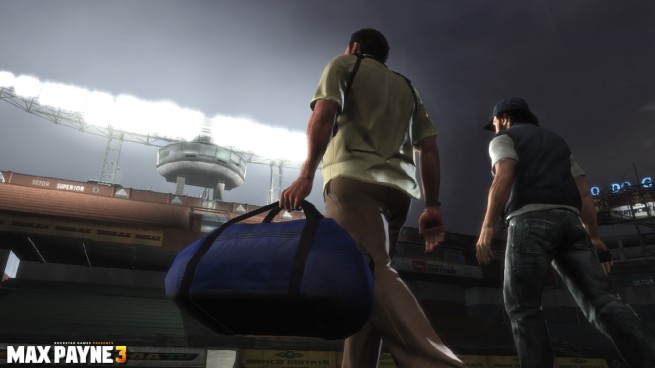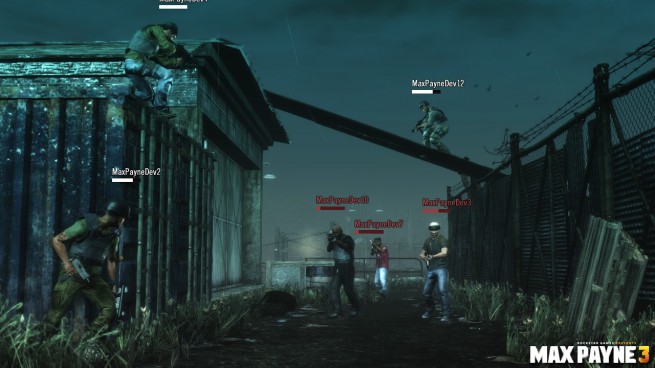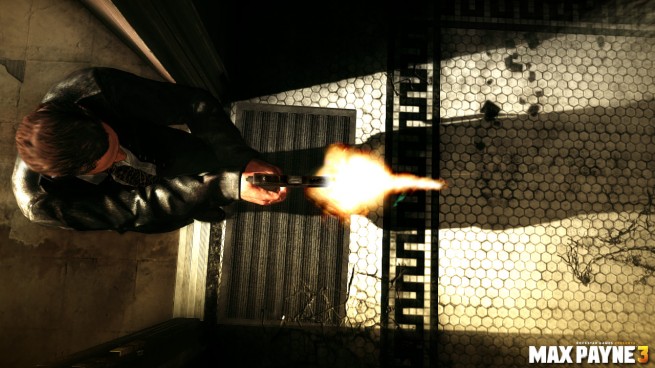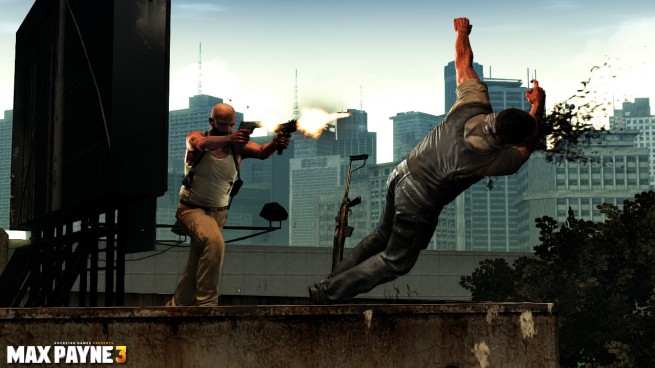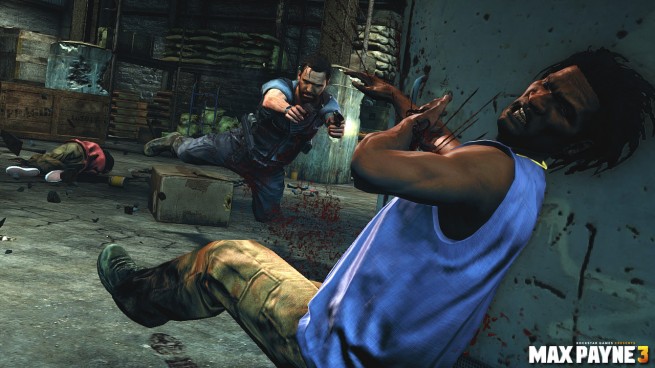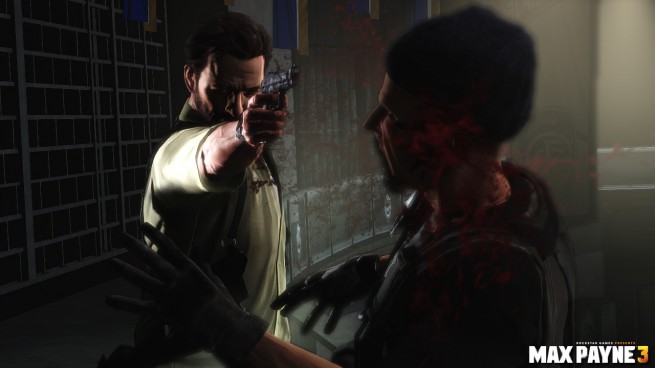Max Payne 3 was meant to be a new chapter in the life of the titular former NYPD detective, who left New York behind to become a bodyguard for Sâo Paulo’s richest family. But while publisher/developer Rockstar’s attempt at a meaningful story may ultimately fall flat, its revolutionary method of delivery manages to raise the bar for video games and provides more than a little excitement when imagining what’s in store for the next Grand Theft Auto. But let’s not get ahead of ourselves….
WHAT YOU’LL LIKE
A seamless interactive story
Even in a game as seemingly pedestrian as Max Payne (story, shoot, story, shoot, story, shoot…), Rockstar has crafted a very technologically impressive experience. From the menu, the single-player story mode starts instantly, launching into the opening cutscene. From that point on, you’ll never encounter a loading screen for as long as you play the campaign. Well, you will — you just won’t realize that you are since all of the loading takes place during the in-engine cinematics. The ample story elements are also subtly interwoven with the actual gameplay, so you may enter a door and immediately go into a cutscene, then a moment later you’ll go from a cutscene back to controlling Max without any jarring transition.
I understand it may seem bizarre to tout such mundane, non-essential aspects of the game. That being said, I’ve played nearly a thousand games in the past few years, and very few have put forth the effort to blend their interactive and non-interactive elements. Video games are the next step in the entertainment evolution, right? So then why is it commonplace for the biggest games of the year, on the most technologically advanced gaming platforms, to never move past inferior traditions passed down from previous generations? Authored cutscenes should pair with player-controlled gameplay like mashed potatoes and gravy, but instead they’re often as sour and jarring as a mouthful of wasabi-laced Vegemite.
Unfortunately, the seamless story mode comes at the cost of replayability. Attempting to replay levels to gather clues and other collectibles is a nuisance since you usually can’t skip cutscenes. That means you may need to sit through five minutes of dialogue just so you can play for 30 seconds to unlock an achievement. I was looking forward to mopping up missed items and finishing the game a second time but was seriously deterred by the inability to expedite the process.
The little things
Gameplay-wise, Max Payne 3 works more or less as it should. The shooting is accurate, the cover mechanic is functional, and Max’s signature bullet-dodge and slow-motion feats are still intact. Rockstar has also taught the old man some new tricks, such as Last Man Standing, where Max will go into a downed state if he has painkillers on him and can revive himself by shooting the enemy who would otherwise kill him.
But what really sets this above every other flashy third-person shooter are the little touches that very few developers seem to care about. For instance, instead of just strapping shotguns and rifles onto some imaginary holster on his back, Max holds larger weapons as a real person would. It’s so obvious and real that it actually becomes novel in a video game. Likewise, whatever smaller weapon Max isn’t using at the time will appear in his side holster, even in cutscenes.
The cutscenes themselves are drenched with little touches that most other devs simply do not seem to realize how drastically they can elevate the overall presentation of a game.
The motion capturing and attention to detail have really paid off.
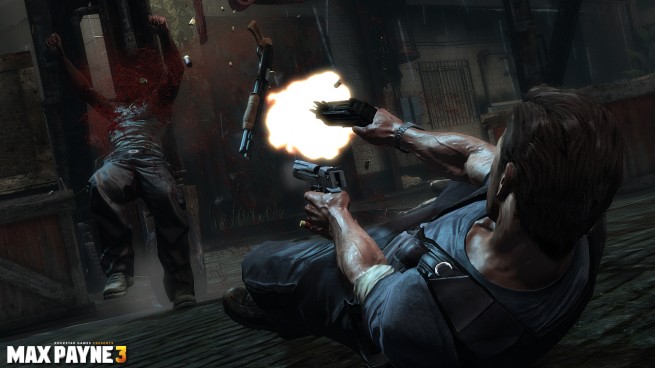
A real multiplayer mode
One of the many ailments afflicting big-name video games in recent years has been the “tacked-on multiplayer” (TM, all rights reserved, Electronic Arts). Dead Space 2 and Mass Effect 3 are two shining examples, but the same argument could be made for BioShock 2 and many others. Here’s the typical publisher mindset:
- Make sequel to single-player game.
- Add multiplayer mode with arbitrary leveling/unlock system stolen from Call of Duty.
- ???
- Profit (and lots of angry fans on Reddit).
Max Payne 3 avoids these pitfalls by building off of the excellent foundation Rockstar established for Grand Theft Auto IV and especially Red Dead Redemption. Though the open-world-exploration element is removed, Max Payne 3’s multiplayer is a much tighter, focused competitive experience.
Everything that you can do in single player you can do in multiplayer and then some. This extends to bullet-time actions, which works surprisingly well. If you have enough adrenaline, you can shoot-dodge in slow-motion, hindering any enemies in your line of sight. Allies in your line of sight will be “chained,” entering bullet-time as well, and so on.
There are tons of items and features to unlock, which I don’t necessarily condone. Like in Red Dead Redemption or Call of Duty, playing, killing, and completing “Grinds” (challenges) rewards you with experience points, and as you rank up, new content becomes available to you. This means that higher-level players will always have the advantage over players who play less, regardless of skill. If I’m level 35, I’ll simply have more weapons, more abilities, more attachments, and more money to buy them all with than someone who just started or is 5+ levels below me.
But once you do start unlocking content, Max Payne 3’s multiplayer potential takes off. At level 4 you’ll be able to customize your own class, choosing your loadout as well as a Burst, which is a special ability activated by adrenaline. The different Bursts add a lot of variety to the game and bring a layer of strategy into what would otherwise be a by-the-books shooter (albeit a good one). One that the Rockstar team liked to use often on me during our play session was Paranoia, which makes all allies appear as enemies. At Paranoia level 2, friendly fire is enabled, meaning you can now kill your friends if you’re not careful.
A good deal of unique modes keep things fresh, too, beyond just deathmatch or team deathmatch. I was happily surprised to find such a robust online counterpart to the single player, and I can easily recommend the game on Max Payne 3’s multiplayer alone.
Replay value
In addition to the endless hours multiplayer potentially offers, Rockstar has padded Max Payne 3 with scores of metagame objectives, difficulties, and bonus modes. Particularly notable are Score Attack and New York Minute, the former of which has Max replaying story levels to rack up the highest score possible by building up a multiplier and stylishly laying waste to everything in sight, while the latter is a race against time, rewarding bonus seconds for each kill. Even if multiplayer isn’t your thing, the game packs enough single-player content to keep you playing long after the credits roll.
WHAT YOU WON’T LIKE
U sad, bro?
Max Payne 3 is set eight years after the events of Max Payne 2, but it’s been over a decade since thugs murdered Max’s wife and child. Yet he can’t. Stop. Talking. About. It. Perhaps if the game didn’t follow previous developer Remedy’s patented inner-monologue stylings, we wouldn’t know how truly pathetic Max was, but since we’re forced to listen to him conjure up new ways to explain how rough his life’s been, it gets old fast. Even Die Hard’s John McClane eventually got over feeling sorry for himself and got his shit together.
The graphic novel-esque cutscenes from previous games contributed to the acceptably bleak, gritty attitude of the main character, but the developers completely removed them in Max Payne 3. I understand and appreciate Rockstar’s attempt to push the game noir concept forward aesthetically, but the end result looks like a graphic design student with epilepsy created it. Combined with the weaker writing and heavy reliance on cliches, and Max Payne is no longer the endearing tortured soul fans once loved.
Story mode wears out its welcome
If listening to a guy named Max Payne whine like a little bitch for 12 hours won’t grate on your nerves, the designers ensured the game will wear out its welcome regardless. The first act of Max Payne 3 is an intriguing, tightly paced, action-packed romp, but even massive shootouts lose their luster eventually. Max seriously can’t leave his apartment (and sometimes he doesn’t even have to do that) without ending up in a gun battle with hundreds of nameless goons.
By the end of the campaign, my stats had recorded over 2,000 enemy kills. Seriously think about that for a minute…. Two. Thousand. And like a Michael Bay movie, the game pushes for one too many drawn-out action sequences. After you’ve stormed yet another enemy stronghold, single-handedly laid waste to yet another entire army, and killed another main bad guy that you only just met five seconds ago, it’s hard to stay excited or care about anything that’s happening.
I was quite disappointed that Rockstar created such compelling, mature framework, then had it devolve repeatedly into standard vehicular shooting-gallery tropes.
Golden guns are another point of contention in the story. Rockstar has repeatedly stated that the plot is the focus of the game, and indeed much of the design corroborates that claim. But then you have the golden gun pieces, which are collectibles spread across each level. This is a two-fold nuisance: One, it completely derails what Rockstar achieved with the clues — non-intrusive collectible items that add an additional layer to the fiction — and two, it’s a little absurd to be running around some of the poorest locations in the world only to find a rocket launcher made out of solid gold lying in plain sight.
The completionist in me had to stop and check every area for the golden gun pieces, even when the plot was screaming at me to “hurry up!” It would have made much more sense for these to only be available on a second playthrough (such as Hardcore or Old School) or some other method.
No grenades
Part of what made Max Payne 2 so great was taking the John Woo-inspired mechanics that Remedy provided and creating your ideal action scene. I stopped progressing the story in a few places, so I could replay a chapter, thinking to myself, “No, I should have done this. It could have been cooler!” And a big piece of putting together that perfect puzzle was the inclusion of explosions and, more specifically, grenades. Max Payne 3 has the occasional explosion, but the single player is completely devoid of grenades.
Well, at least for Max, that is. The enemies throw grenades like they’re going out of style, and you can even shoot them out of the air if you’re quick.
In fact, Max Payne shoots more rockets out of the air than Nathan Drake falls off of stuff.
But you’re never given the ability to throw grenades yourself, which is particularly strange considering you can equip all manner of tossable explosives in multiplayer.
Unrefined controls
My first playthrough was done on Hard in order to unlock the Hardcore and Old School modes (and to impress all of you by stating that in my review!), and aside from a handful of challenging spots throughout the 13-hour game, I managed fairly well. But playing on the harder difficulty(s) made me realize that the controls are not nearly as refined as they really should be.
Exhibit A: Max cannot turn corners while in cover. Some games do it, some games don’t, but this one really needs to. On the harder settings, it only takes a couple of bullets to get downed, so staying protected at all times is imperative. So if you suddenly find yourself on the wrong side of a 90-degree angle, you have to move away from your current cover, clunkily reposition yourself, then reattach to the new cover object, all while a hail of bullets rains down on you.
Exhibit B: Max Payne is old, hurt, tired, and probably more than a little hungover. I get it. But even Metal Gear Solid’s Old Snake could move his ass when he needed to. Whenever Max survives Last Man Standing mode, he’s left lying vulnerable on the ground. Worst yet is that the time it takes him to stand up is ridiculously long. If you don’t suck at video games, ending up in Last Man Standing usually means 20 different people are shooting you at the same time. And so even when you kill the guy who actually downed you, those other 19 thugs are still firing at you.
By the time Max stands up and slowly gets back to cover two inches away from him, you’ve taken enough damage to get downed again. No thanks.
All this despite the fact that Max can outrun snipers out in the open and go toe-to-toe with Neo from The Matrix when he feels like it….
[vb_gallery id=442333]
CONCLUSION
A compelling kidnapping story quickly devolves into pointless mass murder, with the least interesting iteration of this franchise’s protagonist at the center. What’s the point of having extraordinary production values and cutting-edge presentation if you’re not presenting anything worthwhile? Luckily, Max Payne 3’s multiplayer is worth the price of entry alone, and the single-player Arcade challenges are great as well. Or vice versa, depending on your personal preference.
Score: 83/100
Max Payne 3 was released on May 15, 2012 for the Xbox 360, PlayStation 3, and PC. Rockstar Games provided GamesBeat with an Xbox 360 retail copy for the purpose of this review.
VentureBeat's mission is to be a digital town square for technical decision-makers to gain knowledge about transformative enterprise technology and transact. Learn More
